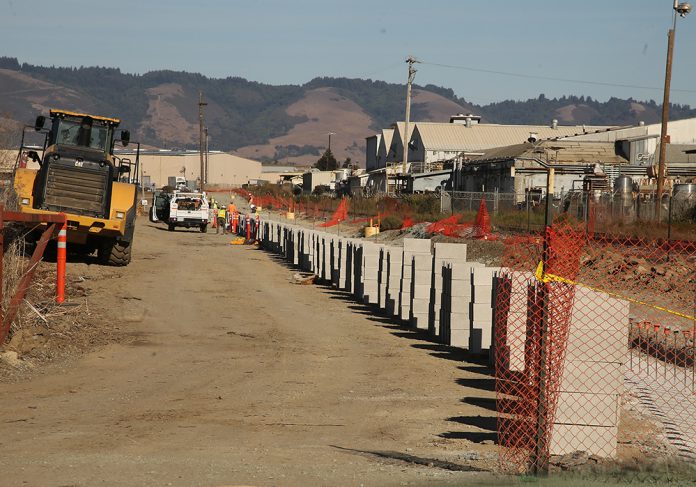
By Jacob Pierce, Good Times News Editor
A new report on the future of passenger transit in Santa Cruz County looks at the future of transportation options for Santa Cruz’s coastal rail corridor in more detail than previous studies.
The Santa Cruz Branch Rail Line is a valuable infrastructure asset—as it lies within one mile of 92 parks, 42 schools and approximately half of the county’s residents, according to the new Transit Corridor Alternatives Analysis and Rail Network Integration Study.
The Santa Cruz County Regional Transportation Commission (RTC) purchased the corridor at the beginning of the previous decade. The commission first approved the purchase in 2010 and finalized it in 2012. Over the intervening years, it became the county’s most contested piece of real estate. The plan has always been to build a bike and pedestrian trail down the mostly abandoned rail line. RTC commissioners and staff have also wanted to introduce passenger rail transit alongside that proposed trail, a plan commonly known as the “rail trail.”
The analysis gave a favorable rating to the possibility of rail passenger rail transit on the corridor—news that the Santa Cruz County Friends of the Rail and Trail celebrated on Facebook.
Ginger Dykaar, a senior transportation planner, helped spearhead the Alternatives Analysis and the Unified Corridor Study that preceded it. She encourages county residents to visit the RTC’s website and check out the public online open house for the project through Nov. 27.
“There’s a rare opportunity here to utilize this right of way as a dedicated transit facility,” she says. “We don’t have a dedicated transit facility in our community right now, and we’re working toward the bus on the shoulders on the highway, but having this [rail corridor] as a dedicated transit facility would really provide another service to people to travel through Santa Cruz County without being stuck in congestion. And it’ll provide an option for people of all ages and abilities to travel that that they may not have right now—people who don’t own a vehicle, people who are younger than the driving age, seniors.”
WHAT ABOUT BUS?
Activists from groups like Trail Now and Santa Cruz County Greenway have long raised concerns about the rail transit idea—such as cost, low projected ridership and the perceived narrowness of the corridor and various potential operational constraints. They argue that a new commuter train would squeeze out the proposed trail, which may be the most popular part of the plan.
But the concept of a trail-only corridor isn’t before the RTC at the moment. When the commission approved the corridor study in January 2019, it voted to pursue plans for some kind of transit on the corridor alongside the trail. That kicked off the new Alternatives Analysis to study what form of transit the RTC should introduce.
One of the frontrunners was passenger rail. But another was bus rapid transit, which would let county residents ride speedy buses up and down the corridor, unimpeded by traffic lights.
Trail-only and anti-train groups have also shown some openness to the bus rapid transit concept.
The RTC slowly narrowed down its options, cutting out a number of proposals, such as one for a podcar-type personal rapid transit system. The newly released Alternatives Analysis looks at four options: bus rapid transit, two types of rail transit and an “autonomous road train” that would run like a bus down the railroad tracks.
The good news for bus rapid transit is that it has the lowest projected cost and one of the highest projected ridership numbers out of any of the options studied. But it still didn’t end up the preferred option.
The report, which is in draft form, lists commuter rail transit and light rail transit as the top two preferred options. In total, each of those two options showed a higher number of benefits and fewer drawbacks, compared with bus rapid transit.
For instance, the report’s projections indicate that the two rail transit options have faster, more reliable travel times, and they would have fewer greenhouse gas emissions.
The bus concept has garnered significant interest, though.
It was the Santa Cruz Metropolitan Transit District that pushed the RTC to begin an Alternatives Analysis in the first place. Metro CEO Alex Clifford warned two years ago that introducing passenger rail service along the mostly rail corridor could be a drain on Metro’s resources, including its funding. Among his concerns, Clifford worried that a new train would basically force the bus agency to reorient all its routes—cutting back on existing routes to instead start shuttling riders to and from the rail line instead, all while competing with the new train for valuable transportation dollars.
John Urgo, Metro’s planning and development director, says his colleagues still share some of those concerns. Although Metro enjoyed collaborating with RTC staff on the report, he feels that the report’s architects at the RTC looked at the major issues more narrowly than they otherwise could have. He worries the report, which is still in draft form, may be asking the wrong questions. He suggests that RTC staff may have been too busy studying what’s best for the corridor itself, when it could have looked at the bigger questions, like what’s best for the future of transportation in Santa Cruz County as a whole.
“We as a region have limited transportation dollars to work with,” he says. “And we should always be asking, ‘What is the best investment for those dollars, whether it’s on the rail corridor or not?”
TALL ORDER
The report also considers it a plus that new rail stations would support transit-oriented development, i.e. greater housing density near train stops.
To many policymakers, allowing for taller apartment buildings near transit stops is a no-brainer. Increased density is one way of meeting two goals at once—building more affordable housing and also making new growth more sustainable. However, many of the neighborhoods near the rail line are currently in single-family residential zoning. That means no one would be allowed to build other types of buildings there without either some type of rezoning effort at the local level or zoning reform at the state level.
Even in the midst of the state’s housing shortage, zoning changes of all shapes and sizes can be a political hot potato in Santa Cruz County.
Andy Schiffrin, an RTC alternate serving on behalf of county Supervisor Ryan Coonerty, chaired an ad-hoc committee to help steer the Alternatives Analysis process. He doesn’t want to share too many of his feelings about the report before the public weighs in, but he’s generally supported studies of passenger rail feasibility.
At the same time, Schiffrin has shown misgivings about increasing density on transit corridors, due to quality-of-life concerns. As a Santa Cruz planning commissioner, he pushed the city to reverse course on its previous plans that could have allowed for taller buildings along some of the city’s busiest bus routes. Still, he says there are plenty of unknowns when it comes to future transportation and land-use decisions in the county.
“I’m always a little nervous about what the future holds. The preferred alternative doesn’t finalize anything,” Schiffrin says. “It’s a next step. Do we want to move in this direction? And there will be next steps in terms of developing a business plan and studying financing. There are all sorts of issues that need to be resolved.”
TRAILER PACKAGE
Bud Colligan, a founder of the anti-train group Greenway, sent a list of 14 questions about the Alternatives Analysis to RTC Executive Director Guy Preston—mostly about details he believes were left out. Colligan says he’s watched as the concerns he raised about the rail trail played out in real-time.
He notes that cost estimates for the rail trail have been going up, and the rail line’s freight operator, Progressive Rail, has shown interest in pulling out of their controversial agreement with the RTC—a 2018 agreement that Greenway criticized at the time. RTC spokesperson Shannon Munz says the RTC is working to address the company’s concerns.
Colligan—a venture capitalist who was involved in the early days of Apple—says government agencies lack the accountability that he’s used to seeing in the business world. “Steve Jobs would come in and fire this whole commission and start from scratch,” he says.
Colligan is fresh off a campaign victory. His chosen candidate Manu Koenig, Greenway’s former executive director, unseated Supervisor John Leopold, an RTC commissioner, in this fall’s election. He says he and his supporters may look to run more candidates in the future.
At this point, RTC staff is focused on the Alternatives Analysis. Munz says they would like to get as much feedback as possible.
“We want to get as input as we can on these draft results before we take this to our commission,” she says. “That online open house is open until Nov. 27. People can go at any time, at their leisure and look around and provide input.”
There will be an online chat session about the Alternatives Analysis Wednesday, Nov. 18, from 6-7:30pm. For information on the Alternatives Analysis and how to offer feedback, visit sccrtc.org/transitcorridoraa.











